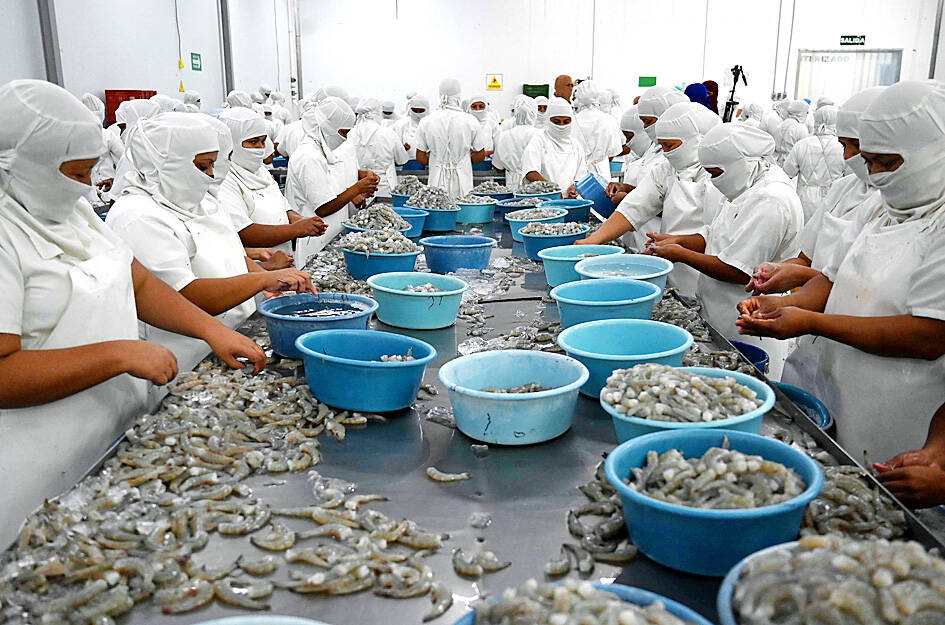Honduras is paying off loans it received from Taiwanese banks according to contract stipulations, the Ministry of Foreign Affairs said yesterday after a Honduran newspaper reported that the country owes Taiwan more than US$440 million.
Honduras has not repaid the debt 11 months after it severed diplomatic ties with Taipei, Honduran newspaper La Prensa reported on Wednesday, citing Honduran Ministry of Finance data.
Taiwan terminated diplomatic relations with Tegucigalpa after the Honduran Ministry of Foreign Affairs in March last year announced on social media that it would cut its ties with Taiwan.

Photo: AFP
This was another example of China using the lure of economic gain to poach Taiwan’s allies, Minister of Foreign Affairs Joseph Wu (吳釗燮) said at the time.
The Presidential Office has made clear that Taiwan would “not engage in a meaningless contest of dollar diplomacy with China.”
The Honduran government justified its decision on the grounds that it was “seeking greater economic support and loans,” the newspaper reported.
The administration of Honduran President Xiomara Castro has not sought loans from Taiwan and the most recent loan it was granted was US$300 million in 2019 when Juan Orlando Hernandez was Honduran president, it said.
The funds from Taiwan have been allocated for housing reconstruction, school infrastructure, school meals and other projects, it said.
In Taipei, Ministry of Foreign Affairs spokesman Jeff Liu (劉永健) yesterday said that the reported debts are commercial loan arrangements by Taiwanese banks to the Honduran government.
The contracts clearly state the rights and obligations of both parties, and include dispute settlement mechanisms and legal jurisdictions, Liu said.
The termination of diplomatic ties does not affect the contracts, so the Central American country still has to repay the loans, he said, adding that it has been doing so.
If there is a breach of contract, the banks can take legal action through international judicial channels, which is standard practice regarding commercial loans, he said.
Meanwhile, Quintin Soriano, the mayor of Choluteca — the capital of a major shrimp farming region of the same name — called on the Honduran government to solve challenges faced by the country’s shrimp industry after Taiwan reduced imports of such products after diplomatic ties were cut and China failed to provide subsidies it had promised, Honduran newspaper La Tribuna reported on Wednesday.
Tegucigalpa terminated commercial and diplomatic ties with Taiwan — a nation with a good market for shrimp — while farmers are reluctant to export to China because prices there are so low and Mexico closed its market to the product, Soriano said.
If the problem is not solved, about 40,000 people in Choluteca region would lose their jobs and “there would be a revolt,” he said.
Taiwan last year reduced shrimp imports from Honduras, but remained its biggest export destination, importing more than 24 million pounds (10,886 tonnes), down from 29 million pounds in 2022, National Association of Aquaculture Farmers of Honduras data showed.

Beijing could eventually see a full amphibious invasion of Taiwan as the only "prudent" way to bring about unification, the US Department of Defense said in a newly released annual report to Congress. The Pentagon's "Annual Report to Congress: Military and Security Developments Involving the People's Republic of China 2025," was in many ways similar to last year’s report but reorganized the analysis of the options China has to take over Taiwan. Generally, according to the report, Chinese leaders view the People's Liberation Army's (PLA) capabilities for a Taiwan campaign as improving, but they remain uncertain about its readiness to successfully seize

Taiwan is getting a day off on Christmas for the first time in 25 years. The change comes after opposition parties passed a law earlier this year to add or restore five public holidays, including Constitution Day, which falls on today, Dec. 25. The day marks the 1947 adoption of the constitution of the Republic of China, as the government in Taipei is formally known. Back then the Chinese Nationalist Party (KMT) governed China from Nanjing. When the KMT, now an opposition party in Taiwan, passed the legislation on holidays, it said that they would help “commemorate the history of national development.” That

Taiwan has overtaken South Korea this year in per capita income for the first time in 23 years, IMF data showed. Per capita income is a nation’s GDP divided by the total population, used to compare average wealth levels across countries. Taiwan also beat Japan this year on per capita income, after surpassing it for the first time last year, US magazine Newsweek reported yesterday. Across Asia, Taiwan ranked fourth for per capita income at US$37,827 this year due to sustained economic growth, the report said. In the top three spots were Singapore, Macau and Hong Kong, it said. South

Snow fell on Yushan (Jade Mountain, 玉山) yesterday morning as a continental cold air mass sent temperatures below freezing on Taiwan’s tallest peak, the Central Weather Administration (CWA) said. Snowflakes were seen on Yushan’s north peak from 6:28am to 6:38am, but they did not fully cover the ground and no accumulation was recorded, the CWA said. As of 7:42am, the lowest temperature recorded across Taiwan was minus-5.5°C at Yushan’s Fengkou observatory and minus-4.7°C at the Yushan observatory, CWA data showed. On Hehuanshan (合歡山) in Nantou County, a low of 1.3°C was recorded at 6:39pm, when ice pellets fell at Songsyue Lodge (松雪樓), a